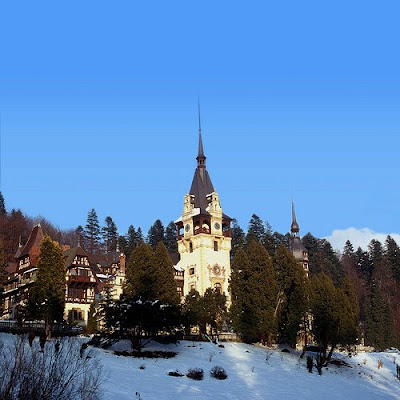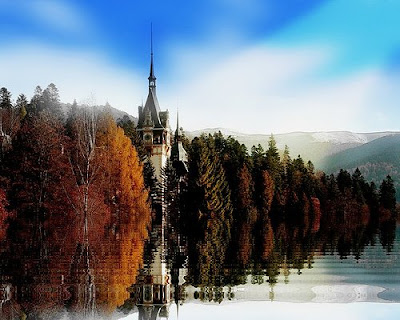


See other Peles Castle post HERE
Most notable grand rooms are:
Holul de Onoare (The Honour Hall) was finished completely only in 1911, under the guidance of Karel Liman, it spreads over three flours. Walls are dressed in exquisitely carved woodwork, mostly European walnut and exotic timbers. Bass-reliefs, alabaster sculptures and retractable stained glass panels complete the decor.
Apartamentul Imperial (The Imperial Suite) Believed to be a tribute to the Austrian Emperor Franz Joseph I, who visited the palace as a friend of the Romanian royal family. Hence why, decorator Auguste Bembe preferred the sumptuous Austrian Baroque in style of Empress Maria Theresa. A perfectly preserved five hundred years old Cordoban tooled leather wall cover is the rarest of such quality.
Sala Mare De Arme (The Grand Armoury or The Arsenal) is where sixteen hundred of the four thousands Peleş Castle's pieces of weaponry and armour reside, one of Europe's finest collection of hunting and war implements, timelined between 14th and 19th century, are on display. The king himself added pieces from his victory against the Ottoman Turks during the War of Independence. Famous are the complete Maximilian armour for horse and rider and a 15th century German "nobles only" decapitation broadsword. Also a wide array of polearms (glaives, halberds, lances, hunting spears), firearms (muskets, blunderbusses, snaphaunces, flintlocks pistols), axes, crossbows and swords (rapiers, sabers, broadswords and many others).
Sala Mica De Arme (The Small Armoury) is where predominantly Oriental (mostly Indo-Persian, Ottoman and Arab) arms and armour pieces are in exhibit, many of them made in gold and silver, inlaid with precious stones. Including chainmail armours, kulah khud helmets, scimitars, yataghans, daggers, miquelets, matchlocks, lances, pistols, dhal shields, axes and spears.
Sala De Teatru (The Playhouse) decorated in "Sun King", Louis XIV style, with sixty seats and a Royal Box. Architectural decoration and mural paintings are signed by Gustav Klimt and Frantz Matsch.
Sala Florentina (The Florentine Room) combines revived elements of the Italian Renaissance, mostly Florence. Most impressive are the solid bronze doors executed in Rome ateliers of Luigi Magni and the Grand Marble Fireplace executed by Paunazio with Michelangelo motifs.
Salonul Maur (The Moorish Salon) was executed under the guidance of Charles Lecompte de Nouy, and as the name suggests it is meant to embody elements of North-African and Hispanic Moorish style. Mother of pearl inlaid furniture, fine Persian Saruk and Ottoman Isparta rugs, Oriental weapons and armour are perhaps the most expressive elements, complete with an indoor marble fountain.
Salonul Turcesc (The Turkish Parlor) emulates Ottoman "joie de vivre" atmosphere, a room full of Turkish Smirna rugs and copperware from Anatolia and Persia. Walls are covered in hand-made textiles like silk brocades via Siegert shops of Vienna.
Labels:
peles castle,
sinaia
Subscribe to:
Post Comments (Atom)







0 comments: